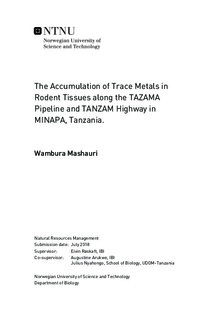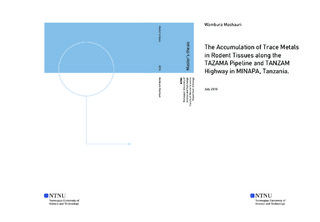| dc.description.abstract | Small mammalian species, specifically rodents, have been used as bioindicators in estimating the level and magnitude of disturbances caused by anthropogenic activities in the environments. Herein, several toxic compounds including trace metals have been analyzed from either the whole body or specific organs including liver, kidney, spleen, heart, and muscles. The study was performed in the Mikumi National Park (MINAPA), Tanzania with the general objective of comparing the accumulation of trace metals in the rodent tissues and soils, along a distance gradient from four study sites including the Tanzania-Zambia Mafuta (Mafuta being the Swahili name for oil) pipeline (TAZAMA), Tanzania-Zambia highway (TANZAM), the intersection of TAZAMA pipeline and TANZAM highway, as well as a control site. Small mammals were collected by traps during a 6-night period from each site using Sherman live traps, baited with a mixture of peanut butter, coconut, and sardines, while soil samples were collected at depth of 0-15 cm using an auger. Four different small mammalians species were collected from all four study sites including Mastomys natalensis (81.2%), Crocidura spp. (16.8%), Lemniscomys griselda maculosus (1.3%), and Acomys cahirinus (1%). The concentrations (mg/kg) of trace metals such as Fe, Zn, Cr, Mn, Pb, Cu, Ni, and Cd, in soils, were analyzed using the Atomic Absorption Spectrophotometer (AAS) while in rodent tissues the Inductive Coupled Plasma-Mass Spectrometry (ICP-MS) method was used. The results showed that; TAZAMA pipeline, TANZAM highway, and TAZAMA pipeline-TANZAM highway intersection, had the highest concentrations (mg/kg) of trace metals in soils, livers as well as kidneys than those from a control site. Meanwhile, the results from all four study sites showed that soils had the highest concentrations (mg/kg) of trace metals than rodent tissues.
However, based on the research findings, this study recommends that conservation education regarding environments should be provided to both investors and road users including drivers, tourists, and passengers who come across with the Mikumi National Park. For the already thrown waste materials in the park, the park authority should take them out and dispose of them in recommended areas as this will help to reduce the rate of pollution in the environment. Lastly but not least, more research is needed on Crocidura spp. that were found having abnormality behind their femurs.
Keywords: Bioindicators, Environmental quality, Infrastructures, Mikumi National Park, Small mammal s, Soil, the gradient of distance, Trace metals. | |

